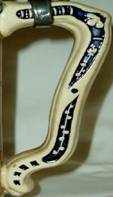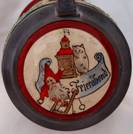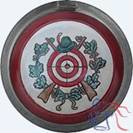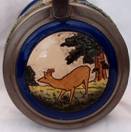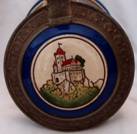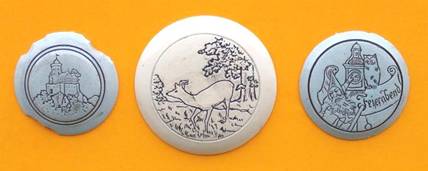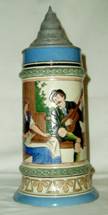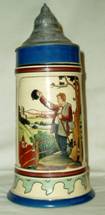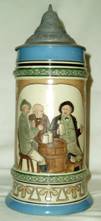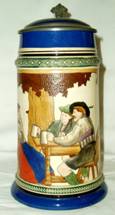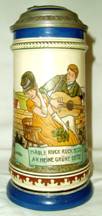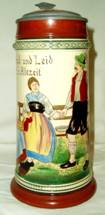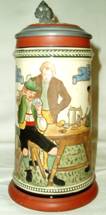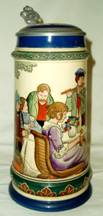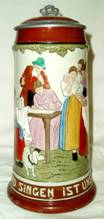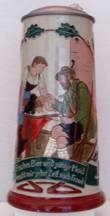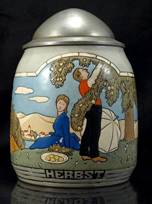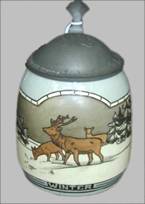Section II
Characteristics of Thewalt Steins
Thewalt steins usually are well-marked with the bottom of the stein containing the form number (some of the souvenir steins discussed in reference 12, contain the same number for various sizes, thus we should refer to them as a form number rather than a mold number), manufacturer’s mark(s), Germany or Made in Germany (if intended for export) and sometimes the word “musterschutz,” meaning registered patent, copyright or registered design. The form number also appears on the body of the stein, usually on the seam between where the handle is attached to the stein. There may have been instances where special orders requested Thewalt not to show their mark. Also, when it wasn’t practical to use their usual mark, a paper label would be attached.
Thewalt used the decimal system or whole numbers for showing the capacity mark and a capital “L” for liter, thus they would appear as 0,4L, 0,5L, 1L, 4L, etc.). Fractions may have been used for some of the souvenir steins discussed in reference 12, since they were produced in smaller capacities (1/16, 1/8, 1/4 etc.) The article in reference 12 refers to the capacity on the small souvenir steins by using fractions.
Some of the Thewalt etched steins in my collection contain three panels, the large one is in the front of the stein and two smaller panels appear on either side of the handle with either other scenes or German phrases. I have identified four handles, shown below, which I believe are unique to Thewalt. One stein has a mermaid handle, but I believe I have seen a similar one on another stein. Thewalt handle 1 has a little bump on the lower inside of the handle, presumably to serve as a resting point for the lower part of the hand when you grasp the handle. The top of the handle is sometimes painted the color of the stein, and is somewhat reminiscent of the black-handled Marzi & Remy steins. Handles 2, 3 and 4 will have the base colors of the stein applied to the handle.
|
Types of Handles Found on Thewalt Etched
Steins |
|||
|
|
|
|
|
|
Thewalt Handle 1 |
Thewalt Handle 2 |
Thewalt Handle 3 |
Thewalt Handle 4 |
The ceramic inserts are easily identifiable as being unique to Thewalt. The one with a gnome pointing to a clock tower, the hands appear to at
|
|
|
|
|
|
Feierabend |
Target |
Deer |
Castle |
|
|
|||
|
Three Blank Inserts |
|||
Some of the etched steins also seem to have distinctive decorations around the bases. As you become better acquainted with the Thewalt etched steins, it is easy to spot them from a distance based on the characteristics I have discussed without looking for the markings on the bottom.
Etched Steins
When it comes to etched steins, of course, Mettlach is the Mercedes Benz of etched steins. They are the highest quality and their numbers dominate the resale market, as can be evidenced in any beer stein auction catalog. You hear of other stein makers mentioned for their etched steins (Hauber & Reuther, Marzi & Remy, Merkelbach & Wick, Mathias Girmscheid, Simon Peter Gerz and J. W. Remy to name a few), but you rarely hear mention of Albert Jacob Thewalt. Although Thewalt etched steins may not be commonly found in auctions as the others are, their quality is right up there when comparing them to Mettlach etched steins. The chart on the next page shows that Mettlach offered more than three times the number of etched steins as its nearest competitor. When you combine that with their higher quality and the probability that their production runs were no doubt greater due to their market share and acceptance, it is no wonder that they dominate the resale antique market today. A further consideration is that when the buyer bought an etched Mettlach stein, they knew it was worth keeping and thus, more would have survived to become an antique. It is also obvious in looking at the chart why Thewalt etched steins are harder to find.
|
Etched Stein Maker |
Number of Molds/Forms for Steins |
Percent |
|
Mettlach (Villeroy & Boch) |
525 |
58.4 |
|
Hauber & Reuther |
167 |
18.6 |
|
Mathias Girmscheid |
54 |
6.0 |
|
Marzi & Remy |
53 |
5.9 |
|
Reinhold Hanke |
44 |
4.9 |
|
Albert Jacob Thewalt |
30 |
3.4 |
|
Rosskopf & Gerz |
23 |
2.6 |
|
Adolph Diesinger |
2 |
.2 |
|
Total |
898 |
100.0 |
|
Source: Search of beer stein catalogs on The Beer Stein
Library using the term “etched” as of |
||
While The Beer Stein Library only includes 30 of the etched Thewalt steins, there are others out there waiting to be discovered. I only have 12 myself, so I am still searching for some to add to my collection.
The first one in my collection is form 327, a 0,5L stein showing a man playing a guitar for a woman. The handle is a type 1. The lid is pewter and the two side panels are mountain scenes showing a church and a house. The base design seems to be unique to Thewalt etched steins.
Form 333 is a 0.5L stein showing a hiker or wanderer. The lid on this one is pewter. The handle is a type 1. The two side panels show German text: Muss ziehen der Wanderer von Lande zu Land, ein Sträusschen am Hute den Stab in der Hand. (The wanderer must walk from place to place, a small bunch of flowers on the hat, walking stick in hand.) The base design seems to be unique to Thewalt etched steins.
|
|
|
|
|
|
Form 327 |
Form 333 |
Form 336 |
Form 390 |
Form 336 is a 0,5L stein showing three men drinking beer by a keg that serves as a table. The Thewalt mold book lists the title as Drei Münchener or Three Munich Men. The handle is a type 1. The lid is pewter and the two side panels show German text: Hopfen u. Malz, Gott erhatl’s. (Hops and malt, may God preserve them.) The lid is pewter and the base design is the same as on form 327.
Form 390 is a 4L stein showing a shooting fest. The lid has a ceramic insert of a target, which is appropriate for this stein. The handle is type 3. The name of the stein in the Thewalt mold book is Auf dem Schießstand or At the shooting stand. The main scene shows several people watching a woman shoot a shotgun at an outdoor shooting fest. The sign above them reads K.K. Schiefsst, an abbreviation for Kaiserlich Königlicher SchiessStand. (Imperial Royal Shooting Booth.) The same scene in relief without the sign appears on Thewalt 462. The German text, which is in a Bavarian dialect, on each side panel reads: A’ Buchserl zum schiassen A’ Stoassring zum schloan, A’ Deand’l zum kussen Muss an echter Bua han. (A real boy must have a girl to kiss, a shotgun to shoot with, a skeet to hit.)
Form 405 is a 1L stein showing an outside drinking scene under a tree. The lid has a ceramic insert of a deer in a glade. The handle is a type 2. The side scenes show a house with hills in the background. The scene is reminiscent of a Franz von Defregger painting.
Form 439 is a 0,5L stein showing a man courting by playing a guitar to a woman. The ceramic insert in the lid is of a castle. The handle is a type 4. They are sitting by a wall with a town and a castle in the background. There are no side panels on this stein. The German text is in a banner beneath them: Madel, ruck, ruck, ruck an meine grüne Seite. (Girl, move, move, move to my favorite side.) This is a mid-19th century Swabian folksong and the reference to his favorite side is where his heart is. Again, the base of the stein is probably unique to Thewalt etched steins.
|
|
|
|
|
|
Form 405 |
Form 439 |
Form 463 |
Form 474 |
Form 463 is a 1L stein showing an Alpine couple dancing while a woman plays a stringed instrument and another man with a pipe and a walking stick watches them. There are no side panels on this stein. The German text above them reads: In Freud und Leid trink Allezeit. (In happiness and sorrow, drink all the time.) The lid is the most popular ceramic insert, a Gnome pointing to a clock tower with an owl sitting on a banner with the German word Feierabend. The handle is a type 2
Form 474 is a 0,5L stein showing two men playing cards while a third man watches them. There are no side panels on this stein. The German text in a banner on each side reads: Trink was klar ist, sprich was wahr ist. (Drink what is clear, speak what is true.) The lid is the most popular ceramic insert, a Gnome pointing to a clock tower with an owl sitting on a banner with the German word Feierabend. The handle is a type 4.
Form 494 is a 1L stein showing an outdoor gathering of a family with a young man playing the flute for a young woman with flowers. The older couple behind the young woman have goblets, so they probably are drinking wine. A little boy is blowing soap bubbles. The Thewalt mold book lists the title as Vier Lebensalter or Four periods of Life. There are no side panels on this stein. The banner on each side of the bottom has German text that reads: Wein macht fröhlich, Bier macht selig. (Wine makes one happy, beer makes one blissful.) Ah, the older couple is being scolded for their poor choice of beverage. The lid is the most popular ceramic insert, a Gnome pointing to a clock tower with an owl sitting on a banner with the German word Feierabend. The handle is a type 2. Again, the design of the base appears to be unique to Thewalt etched steins.
Form 542 is a 1L stein showing an outdoor gathering with two couples dancing, one woman sewing, one woman who appears to be crying and an older man with a pipe. The Thewalt mold book lists the title as Lustige Leut or Merry People. There are no side panels on this stein. The German text on the bottom reads: Tanzen und Singen ist unsre Freud. (Dancing and singing is our joy.) The lid is the most popular ceramic insert, a Gnome pointing to a clock tower with an owl sitting on a banner with the German word Feierabend. The handle is a type 3, which may be used on taller 1L steins versus the handle type 2 used on shorter 1L steins. Form 542 is 9.5 inches tall, while form 405 is 8.25 inches tall.
|
|
|
|
|
|
Form 494 |
Form 542 |
Form 601 |
Form 642 |
Form 601 is a 1L stein that is relief and etched showing a hunter with his hunting dog and puppies. The Thewalt mold book lists the title as Junge Dackel auf dem Tisch or Young Dachshunds at the Table. The handle is a type 3. There are no side panels on this stein. The German text in the banner at the bottom reads: Frisches Bier und junge Maid macht mir jeder Zeit noch Freud. (Fresh beer and a young girl always makes me happy.) The scene is circled with vines on the sides and top and a banner with German text on the bottom, both of which are in relief. The lid is the most popular ceramic insert, a Gnome pointing to a clock tower with an owl sitting on a banner with the German word Feierabend.
Form 642 is a 0,5L relief and etched stein showing a man bowling while three
|
|
Forms 714 and 715 are 0,5L steins in the jugendstil style. The lids are also in the
|
|
|
|
Form 714 |
Form 715 |

